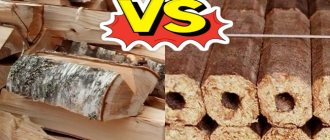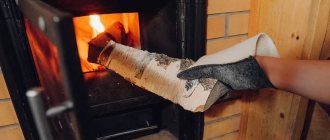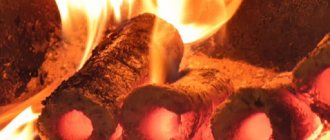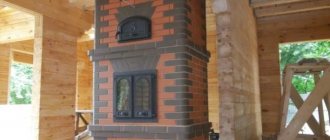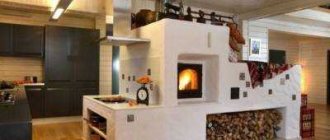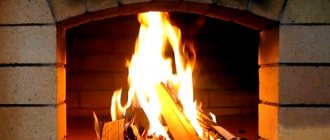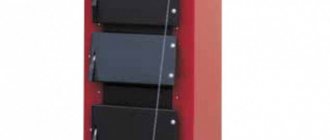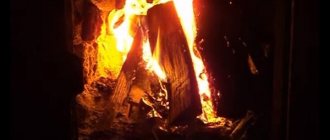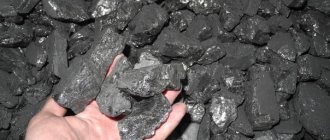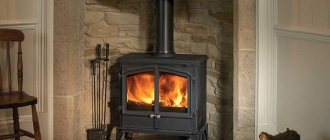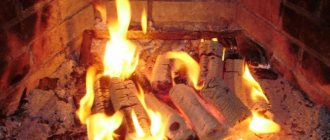With the arrival of cold weather, every owner of a heater or stove asks the question: how to light the stove at home? The diligent owner stocks up on raw materials a year before the heating season. During this time, they dry in a woodpile, where they are protected from rain and snow. The shed should be well ventilated to prevent the wood from rotting.
There are times when you didn’t prepare in advance, but the camera needs to be lit at that moment. You only have imported material that is not prepared for heating a house or bathhouse. You did not have the opportunity to prepare dry dead wood. This is not a reason to be upset, we will look at several methods of ignition.
How to light a stove with raw wood - without special tools
Many people mistakenly think that they can handle raw timber with kerosene, diesel fuel or gasoline. You just have to splash a little liquid into the fireplace. This will lead to fatal consequences, including setting the premises on fire. You can also be poisoned by combustion products if you do not open all windows and doors wide open. There are other ways, you just have to be patient, because the procedure will take a lot of your time:
- It’s good if you have dry logs left over from last year. Then you should first divide them with an ax or knife into thin chips. Crumple up more paper, put prepared torches on it, and light it. Let the fire burn. At this time, prick the wet bars as thinly as possible. And carefully place them on the hearth like a hut. Do not try to speed up the process; do not add all the logs at once. This will lead to smoke in the room, the formation of soot and soot in the pipe. Once the red coals appear, you can place thicker dies there. You just need to make sure that there is a small distance between them to allow oxygen to get into the fire. Next, follow the method: your hand can’t stand the heat over the fire, so it’s time to add the rest.
- How to heat a stove with raw wood? A little harder and longer. Many stokers know from experience that smoke and soot will be present here. But as soon as the first batch of brushwood flares up, you can add wet wood. There will no longer be any difference between dry and wet fuel. The heat transfer from the fire will be the same. Even people deliberately delay the combustion process by throwing raw material into the firebox in order to increase the period of time for adding a new batch. Because dry dies light up quickly, but also burn out instantly. And you will constantly think about maintaining heat in the house, and run to the unit again and again.
What is order
What is order and why is it needed? This is a detailed diagram according to which the furnace is laid; without it, work cannot begin. Even experienced stove makers first draw up an arrangement plan, and then begin laying. This order indicates the location of the bricks for each individual row, their sizes, places for installing doors, fireboxes and other grates.
An example of the arrangement of a brick stove.
The laying of stoves can be carried out using various methods, for example, undercut or with empty seams. If the first method is used, then after completion of the work the surface of the stove is not plastered, since the solution has already filled all the seams. Laying can be done in one brick, in ¾, in ½ - it all depends on the size and appearance of the structure.
The masonry rules provide for the use of only special oven bricks. The use of slotted, silicate, conventional fireproof, expanded clay is not allowed under any circumstances. The first row must be laid out dry, that is, no solution is used. It is necessary to clearly determine the direction of the future masonry; if necessary, the brick can be easily repositioned. At the same time, the position of each door and front wall is determined. The second row is laid out with mortar, followed by laying the corners of the future fireplace or stove. During work, plumb lines and string must be used so that the wall goes vertically upward and does not have displacements or deviations. The masonry rules are the same for any structure. The ash pit, firebox, and ash pit may be located in different places, but their fastening and reinforcement remains the same.
This masonry begins after the second row above the firebox of the future furnace. When laying the cladding, you must remember that a rigid connection between it and the stove cannot be made, since the temperature characteristics will be completely different and cracking is possible. When laying a chimney begins, you must remember to install a special valve; it must be smoothly and well regulated.
How to heat a stove with raw wood: basic techniques
First you need to figure out what type of wood is suitable for heating the room. Experts say that non-coniferous wood is best suited for this purpose. Pine and spruce, when burned, release resin, which is deposited on the walls of the chimney. They also do not maintain optimal temperature.
Depending on your geographical location, you choose the timber that grows in the immediate vicinity of you. We will give a brief description of the more relevant categories of raw materials:
- Pine. It has a high degree of combustion, releases a huge amount of resin, and is characterized by internal voids. When ignited, sparks fly and the log explodes into separate pieces.
- Spruce. They heat it when absolutely necessary, as it brings little heat, smokes, and smolders. But it pricks easily.
- Alder and aspen .
If you heat the stove with raw wood from these species, you will solve another problem at the same time. They are the only ones that clean the chimney of tar and soot. - Poplar. The cheapest wood. It does not produce much heat, burns out very quickly, and requires constant presence near the heater. You can’t heat a bathhouse to the optimal temperature.
- Birch. Just like poplar, it burns quickly and has little heat transfer. In this case, a constant flow of air is required, otherwise the birch logs will smoke and not produce heat. It is better not to use wet dies from these rocks, because the released resin will quickly damage your heating system. You will have to call a specialist to clean out the clogged smoke exhaust system.
- Oak. Optimal type for heating. It burns for a long time and produces a lot of heat. The only negative is that it pricks hard when dry. Therefore, it must be processed immediately after felling.
- How to light a stove from an apple, pear or other fruit tree? This question is asked by owners of private houses, summer cottages and garden plots. There is no need to throw away cut logs. They provide excellent heat transfer. In addition, the room is filled with a fruity aroma, which has a beneficial effect on people’s well-being.
- Linden and maple. They are convenient and easy to prepare into bars, but do not produce charcoal when burning, leaving only crumbly ash. And this affects heat transfer. These breeds require special attention from the heater owner; logs need to be added every half hour.
- To heat the living space, you can use peat briquettes and pellets made from pressed sawdust. In Asian countries, dung is widely used.
Features of the combustion chamber of different types of furnaces
There are several types of stoves, depending on the material:
- Made of stainless steel;
- Cast iron;
- Brick.
How to properly heat a metal stove?
More often, these heating devices are found in bathhouses, but there are often cases when residents of ordinary rural houses build them for themselves. It is imperative to take into account the temperature in the wood burning stove when working with such a structure. Although such stoves are small in size, not every owner knows how to heat them in order to maintain heat in the room for a long time.
The general rules are identical for all types of stove structures, so do not be afraid of this matter - there is absolutely nothing complicated in it, every master can do it if desired:
It is important to remember that when working with metal stoves, there are several important restrictions that must be met immediately when starting work. First of all, in order to properly light the stove with wood without wasting it, you should not use flammable mixtures sold in stores to water the wood. This has an extremely negative impact on both the environment and the general health of the stove maker - an excessive abundance of chemicals, as well as the forced need to breathe their vapors for a long time, have not benefited anyone. Prefer to these auxiliary products special alcohol tablets, sold in the same section of the supermarket as lighter fluid - they burn for a long time
Thanks to them, firewood ignites quickly, easily, and also has a much lower level of toxicity. They can be used if there is a need to work with poorly dried firewood.
Features of working with a cast iron stove
One of the main rules for working with such a stove is to keep the doors and the blower structure tightly closed. The device for regulating the air draft must remain wide open - this is the only way to ensure the best quality of work with a stove of this type. In order to properly stack firewood in the stove, without fear of getting thermal burns, purchase special gloves to protect the skin of your hands, and an apron so as not to contaminate your clothes with soot. Be sure to take precautions during work - when loading each new portion of firewood, you must carefully open the doors, in no case in a hurry - the intra-stove pressure must certainly return to normal.
Properly heating a brick stove
In the first half hour of operation, such a structure must be heated very intensively, exactly until the optimal air temperature in the room is reached.
When the desired value is reached, a draft regulator should be installed to avoid a further decrease in temperature. The temperature in the firebox of a wood-burning stove must be stable. This will help significantly reduce raw material costs.
Brick stoves have the largest dimensions compared to other types of heating devices, so only physically resilient people who do not have health problems can work with such a structure. To ensure the smooth functioning of such a stove, you often have to lift heavy objects.
How to properly heat a brick stove with wood in winter?
In order to ensure maximum heat production in a brick kiln during the cold winter period, certain operating conditions must be observed. Keep in mind that in this case you simply need to know how to properly place firewood in the stove - each new load of firewood must take place at intervals of at least forty minutes.
Procedure for kindling
Experienced stokers don’t have a question: how to quickly light a stove with raw wood? They elevated their work to the level of art. Because they know that wood gives off heat at a temperature of 300 to 400 degrees. And to heat rooms it is not enough to maintain a fire at 50 °C. This will only lead to smoke.
For an optimal kindling process, experts give several recommendations on how to reduce fuel consumption and increase heat:
- It is preferable to prepare raw materials that are five centimeters smaller than the combustion chamber.
- The size of the chopped log should be approximately the same.
- It is necessary to remove all burnt ash and coals from the furnace, and clean the grates from tar and soot.
- Then check for the presence of traction, first light the paper. And look at the direction of the smoke. If everything is in order, then it will go inside the firebox, and not out.
- We begin to make a seed: we place two logs parallel to each other, and between them is a crumpled piece of paper. Sawdust and shavings are poured on top. Two more beams are placed on top of this structure. Next, we set it on fire with the blower open so that there is additional air supply.
- When the heater begins to hum, then close the lid, but not completely.
This method is suitable for dry logs, but how to light a stove with wet wood? Stokers give their recommendations:
- Chop the block lengthwise into several pieces.
- If it is a birch tree, then remove the bark, as it will interfere with the kindling.
- From the inside, pinch the splinters, which are not so wet.
- There should be a large number of such chips. Because they will have to maintain the fire for 15-20 minutes until the firebox warms up.
- Place the prepared splinters in a “hut” on the crumpled paper.
- When the fire is burning properly, you can then add thin dies.
- Wait another twenty minutes, then add the raw logs to the hot coals.
- Cover the vent and monitor the combustion process.
- Don't let the fire go out, otherwise you'll have to do it all over again. Periodically add wood to the flame.
- Watch the draft so that smoke does not enter the room.
Characteristics of the best tree species
Deciduous trees are, of course, better suited for the stove, because their fiber structure is dense. They burn tightly and give off heat well. This also includes fruit trees, which emit pleasant aromas when burned.
Although conifers also burn well, they just smoke and smoke a lot due to the high concentration of resin. In addition, they burn out quickly. In a word, let's move straight to hardwood.
Larch
To determine which wood is best to burn the stove with, you should familiarize yourself with each of the options in more detail, study their parameters in the light of the combustion process.
Oak
Oak is, first of all, a hard and valuable tree, and only then - fuel. This is why oak firewood is elite and therefore expensive. Note: real good pizza is cooked exclusively on oak wood.
Trees that are not too old (middle-aged, so to speak) are used as firewood, since they produce more thermal energy and combustion lasts longer. The heat that young trees give is too weak, and the room will smell of wood that is smoldering. As for the old ones, they leave a large amount of ash with smaller volumes of thermal energy, and the air in the house becomes “heavy”.
For this reason, it is advisable to burn oak in the fireplace.
Linden
Let’s immediately say that linden wood is ideal for heating baths. When burned, they emit a sweet aroma that has a beneficial effect on the respiratory system. It is difficult to ignite such wood, but the heat that is generated is long-lasting and persistent. It is also characteristic that they can be stored for no longer than two years.
Birch
Birch firewood is also hard (like oak), and therefore is also an excellent option for a stove. Of course, in terms of their ability to produce heat, they are somewhat inferior to oak, but they are approximately 20 percent superior to coniferous species in this indicator. Moreover, they burn for a long time, with an even flame, and do not spark.
The only drawback of birch wood is the large amount of resin, especially in the bark. Therefore, it is strictly not recommended to heat a stove with bark. And when burning the wood itself, a lot of soot is released, which settles on the walls of the chimney.
When birch wood burns, the house is filled with unique aromas, the air is disinfected, and the people who live there suffer less from respiratory diseases. We also add that a birch tree that has been left for more than two years loses these medicinal properties. Therefore, it cannot be stored longer than this period (as well as linden).
Aspen
There is not much to say about aspen firewood. They are not easy to light, produce little heat, and burn out fairly quickly. They are characterized by a long, bright flame and lack of smoking, which is why they should be used to clean the chimney duct. But if we talk about what kind of wood is best to heat the stove with, then the answer is obvious: definitely not aspen.
Alder
Alder is rightly called the “royal” tree. The fact is that this wood flares up quickly, contains a small amount of resin, releases a lot of thermal energy, but practically does not emit smoke. The ideal area for using alder is the “black” firebox in a bathhouse. Moreover, when burned, the tree emits a pleasant aroma that prevents colds.
We also note that with the help of this firewood you can also clean the chimney after resinous conifers. They are also great for barbecue, and alder sawdust is used for smoking meat and fish dishes. The wood dries quickly even in natural conditions, and is stored for more than three years. During this time, its characteristic aroma is not lost.
Poplar, willow
The stoves are heated with wood from both poplar and willow. But a significant drawback of both options is the rapid burnout, and even the insignificant (when compared with other breeds) cost does not provide savings, because heating the house will require a larger amount of this firewood.
Willow and poplar are definitely low-grade wood, which is bought only when it is not possible to buy something better.
Fruit trees
Such breeds are optimal for heating and can quickly warm up, but despite this, they are used mainly for smokehouses or fireplaces due to the fact that these varieties are rare.
Basically, such firewood can be obtained by cutting down old orchards. They (firewood) are stored in order to cook food over an open fire.
How to speed up kindling
Many hunters give advice on how to quickly dry firewood. They saved more than one frozen life in extreme conditions. There are prepared woodpiles in the parking lots, only in the open air, where rain falls on them. Accordingly, during winter, they freeze and become covered with ice. But this does not prevent hunters from warming up. They use several old folk techniques:
- It is necessary to clear the lumber of snow.
- Chop into small slivers.
- Melt the unit, as we wrote earlier.
- Just throw two handfuls of coarse table salt onto the paper. It will absorb excess moisture.
- If you don’t have a newspaper at hand, take a piece of plastic or roofing felt. You will spend a little more time lighting these items.
- If this is not the case, then vegetable oil will help you. You can pour a tablespoon onto the wood chips. Or fill a liquid bottle with sawdust, shavings, newspaper or dry rags. And also put it in the fire.
- Use diesel fuel and gasoline. But there is no need to splash them into the combustion chamber. You need to soak a piece of rag in the liquid and place it next to the wood chips. Then you will avoid a fire hazard.
Of course, you can suffer for a long time with an old heater or stove, but in the end you will achieve results. But will it give you all the heat, will it be reliable in operation, will it withstand the load of wet wood? Before building a house with stove heating, you should contact specialized stores for advice.
Checking traction
The mechanism of operation of the smoke channel and the blower, as a rule, remains hidden from view, so its effectiveness is sometimes ignored. Moreover, even if the channel is opened, there is no guarantee that it fully meets the oxygen needs of the hearth. This system is clearly visible in cast iron and steel structures. The question of how to properly heat a metal stove from the point of view of sufficient supply of air masses comes down to assessing the brightness of the flame. An experienced stoker determines the adequacy of the oxygen supply by the color of the fire. So, white color indicates that the channel is open too much, and the valve should be closed a little. Conversely, a bright yellow tint indicates that the lesion is receiving a normal flow of oxygen.
How to quickly dry firewood
If you did not take care of the preparation of logs in advance, and you need to heat the constructed structure right now, then you can get out of the situation:
- The raw material is sawn and split to the size needed for your system.
- We stack the finished dies next to or above the heating structure so that air easily circulates between them (a well or a thin layer).
- Please remember that the drying material may ignite! Therefore, safety precautions must be observed. Direct contact with very hot parts of the heating device must not be allowed. A tree can catch fire even at a distance from infrared radiation!
- Such actions will allow you to quickly solve the ignition problem.
- Logs, without direct contact with precipitation, dry in wet autumn and severe frosts. The conclusion from this is to store logs indoors.
- Soft woods such as pine, spruce, aspen, and poplar are most suitable for ignition. It must be kept in mind that they burn very poorly when wet. But they are easier to dry than oak, ash or birch.
Types of wood by moisture level
It happens that the firewood is damp or simply not there, and the house needs to be warmed up. Then freshly cut trees are used. It is better if it is birch or aspen. Oak may also work, but it will be difficult to split. The speed and quality of kindling depends on the moisture content of the firewood.
Wood is divided into a number of categories based on moisture level:
- 0% - completely dry. It is rare due to the natural humidity of the air indoors or outdoors.
- From 7 to 20%. This importance can be achieved by drying the tree in a special chamber or by keeping it in a warm house all winter.
- 20 -45%, normally dried wood from a woodpile.
- 45-80% is fresh firewood, just cut. Winter and autumn firewood will be more moist. It is difficult to heat with them; you need to follow the kindling technology.
- Wood that has been in water for a long time has more than 80% humidity. It is generally impossible to drown like this.
Nuances of ignition
Our ancestors also advised that anything that burns can ignite a heating unit. Take the materials that you have available: hay, straw, old newspapers and magazines, birch bark from sawn dies, plastic dishes, plastic bottles, sawdust and shavings.
By the cold season, you should carefully check the condition of your stove, clean the chimney of last year's soot, remove ash and old coals from the furnace, check the serviceability of the grate, and check the draft with lit paper. Make sure your latches and lids open and close smoothly, so there are no unnecessary gaps. Only after all the manipulations can you begin the heating process.
Lighting a heater or stove does not require fuss or acceleration. Be patient, otherwise you will not only have to sit near the unit for a long time, but also ventilate the entire room from carbon monoxide. If you lit a “hut” of wood chips and started to smoke, do not panic. Open the ash pit, close the firebox and wait until the accumulated smoke stops the fire and leaves through the hole, simultaneously warming up all the pipes. After a few minutes, try again, just add more dry material. Alder or aspen are best suited for cleaning a chimney, as they will help burn off last year's resinous deposits. When the combustion has stabilized and draft has appeared, you can start laying wet firewood. Just watch the intensity of the fire so that the water does not extinguish it.
You must remember that the filling of the firebox at the initial stage does not exceed 30 percent of the volume of the chamber itself. After the temperature of the brick becomes optimal, that is, the heater is warm at hand, you can add wet logs every 2 hours. In this case, it is strictly forbidden to close the damper and vent completely. They should be slightly open to increase the heating time.
Principles of firing a brick and iron stove
Many people think that heating a stove is not such a difficult task.
Heaped up some wood, set it on fire and waited until the house became warm. In fact, in order to heat the stove correctly, you need to know some features. Otherwise, you can burn a lot of wood, and the house will be cold. Before putting firewood into the firebox, it is necessary to clean the ash chamber and grate from the remnants of previously burnt fuel. This will ensure a direct flow of air through the blower to the flame. To light the stove, it is recommended to use only dry wood. Wet or damp logs cannot be used, as this will lead to smoke and large deposits of soot in the chimney.
If you add coal, you need to select medium size. Small and too large fractions are not suitable for home ovens.
At the beginning of the heating season, the firebox needs to be thoroughly cleaned.
Place logs in the firebox. This can be done in two ways:
- hut (under a cone) if the firebox is large;
- parallel (with gaps of 8–10 cm).
Firewood should make up approximately two-thirds of the volume of the combustion chamber. There should be a free space of 15–20 cm to the top. It is better to place firewood directly in the center of the firebox or closer to the stove door, but not closer to the back wall.
Move the view to the required level. Open the ash door slightly. Using matches or thin wood chips, we set fire to a piece of birch bark or paper placed in front of the firewood.
As soon as the flame begins to engulf the wood, close the doors of both the firebox and the vent. When they begin to burn evenly, lightly cover the view.
The view allows you to regulate the combustion process
We control the fire using a view and a blower, which provide air access to the fire. Keep the combustion chamber door closed. We open it only if we need to stir the coals with a poker or add firewood.
If the stove is constantly fired with coal, when setting it up, you first need to burn a small portion of firewood and after that add a 5-6 cm layer of coal. After it flares up, add fuel up to 15 cm, then the stove will burn well and warm up evenly.
How to determine if wood is burning correctly:
- If the flame is white and noise is heard in the exhaust channels, it is necessary to close the ash door. This is an indicator of strong traction.
- If the flame has acquired a red tint and black smoke is coming out of the chimney, the draft is too low. We open the vent.
- A yellow flame means optimal combustion.
For greater efficiency, do not stir the wood until it is half burned. Only after this can they be moved with a poker. Collect burnt coals in the center of the firebox, surrounding them with burning wood and coals. In this case, it is best to close the blower door or view.
It is not recommended to constantly stir firewood
If the flame in the firebox goes out, this means that carbon monoxide has formed inside. Most likely, the firewood was wet or damp during storage. Of course, it's best not to use them. But if there are no other options, then close the firebox door and completely open the view and valve. Light the fire again and wait 10-15 minutes. During this time, carbon monoxide will disappear. Now open the door and dampers a little, and you can continue heating.
It will take 1.5–2 hours to heat the stove well. In this case, the surface heats up to 70–80°C, less often - up to 90°C. At higher temperatures, dust burns on the stove and an unpleasant odor appears. Due to overheating, cracks may form in the masonry and the device will quickly fail.
After the firewood and coal have completely burned out, the view is closed. This is necessary to maintain heat in the house until the next fire.
The process must be completed by following certain rules:
- When the wood burns out, gradually close the vent and the valve.
- After only coals remain in the firebox, you need to collect them in a heap on the grate and cover the ash pan with the view about 2/3 or 3/4.
- Only after the blue lights have completely disappeared (the process of carbon monoxide combustion), the coals can be scattered throughout the firebox and the view and door can be tightly closed.
- If for some reason it is necessary to stop the combustion process of the stove if there are unburned firebrands, you need to remove them and extinguish them yourself. It makes no sense to fill them with water. This can lead to smoke and unnecessary dampness in the combustion chamber.
In winter, it is better to heat the stove twice a day. Then the house will not cool down. The exception is the Russian stove. It can be heated only once a day, since heat transfer occurs much later.
Causes of smoke
Sometimes, even when the stove is properly lit, smoke may form. The reason may be poor quality coal. But most often the following factors influence smoke:
- the appearance of cracks in brickwork;
- presence of blockages in the chimney and stove channels;
- destruction of the internal part of the heating device.
The appearance of smoke may be due to blockages in the chimney and stove channels.
When igniting in a very cool firebox, smoke may also be released in the entire stove system. Soot often forms when two stoves are directly connected to one chimney. To avoid smoke, a smoke damper is installed.
Reloading
Long-burning solid fuel devices are designed in such a way that one fill lasts for a long time. With regular wood-burning stoves, one serving doesn't last long. At best, not 6-8 hours. Therefore, to maintain the operating mode, it is necessary to re-bookmark. It is performed when the wood is almost burnt out, but a bluish light flame remains.
In the process of laying a new portion, two important conditions are met. First, carbon monoxide must not be allowed to enter the room. Secondly, you need to keep the temperature high, which will make re-kindling much easier. Therefore, they do everything as quickly as possible. They begin by carefully raking the smoldering remains of firewood and coals into the center of the chamber. So that they are in the middle of the new bookmark. Then everything is done the same way as the first time.
Simple solutions
The algorithm of actions depends on the following factors:
- type of wood;
- the presence of a special means for ignition;
- stove location.
Damp aspen does not burn, but “melts,” and does not emit sufficient heat to dry the wood chips. Softwood firewood ignites more easily because it contains resins and essential oils. Birch burns best in its raw form, although it also requires time to ignite.
One of the options for solving the problem is to buy some dry firewood in addition to wet firewood, and mix the heat in the stove. You can light a fire using wood chips cut from dry logs.
How to heat with raw wood? You need to do the following:
- pinch a splinter from the middle part of the raw firewood and fold it in the form of a hut, with the larger one on top and the smaller one inside;
- If you have birch firewood, remove the birch bark from it and use it to light a flame.
In this case, thin wood chips or birch bark dry out a little, and when ignited they create heat, under the influence of which the moisture from the firewood gradually evaporates and they ignite without even drying completely.
Safety regulations
The main hazards when using furnaces are carbon monoxide and fire. For safety reasons, follow a few rules:
- inspect the stove before lighting for traces of soot;
- do not use flammable liquids for ignition;
- finish heating 2 hours before bedtime;
- Use fuel that is suitable for this type of stove.
In conclusion, we note that brick stoves are heated to the maximum, and metal stoves - in small portions to avoid warping of the body.
If you have glass smoking near the stove door...
In any oven there are times when glass smokes. This often happens during kindling, when the stove is still cold or the air lock has not been “broken.” The combustion temperature is not yet high, and there is a lot, a lot of unburnt gases, smoke, which does not have time to escape and can swirl around the glass of the door.
Glass blowing measures do not always help, although we try to make fireboxes with glass ventilation. It may be trivial to have damp firewood (among other things).
What to do in such a situation?
Just try for the first 15-30 minutes of the fire, while the wood is burning, open the fire door 0.5-1 centimeter, this is enough to cut off the smoke from the glass. This will also provide additional oxygen for lighting the stove. With this calculation, you can open the blower a little less.
